Innovation – what it means to me, and what it means to forestry
July 6, 2020 2:22 pm Leave your thoughts
It’s that time of year when you start to wonder why the temperature is hitting 30 degrees and you realize “oh no, summer is half over”. That’s how I’ve felt this past week. I can’t believe that it’s already July and everyone is making the most of Canada’s birthday. I’ve had an interesting week in the field as I was given a new toy to reduce the risks of heat stroke associated with spending long days walking cut blocks.
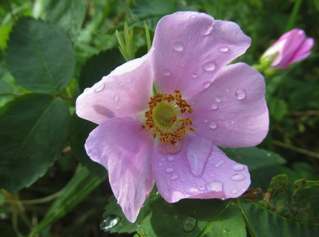
Wild rose.
This week I wanted to challenge myself and attempted to make a vlog to keep things interesting. So, for your PURE entertainment, I present to you “Drones get the best of me”. I thought it would be fun to show you guys as I try the Mavic 2 in the field. The hot topic for this week’s blog is the word “innovation”, in regard to self-improvement and technological advancements. There is a lot of talk lately about integrating more and more technology into forestry. This has been done in all aspects of the industry from planning to harvesting and has definitely allowed companies to become more efficient and understanding of the land in which they are working with.
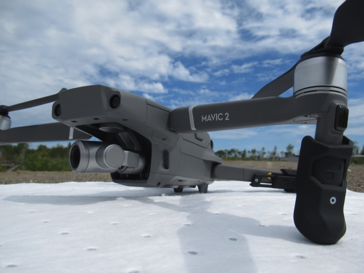
The Mavic 2.
GIS revolutionized documentation and maps (colouring within the lines used to be a qualifying skill for any R.P.F), and now LiDAR is changing the way we do inventory. Being a silvicultural intern for Resolute has really opened my eyes as to how forestry is constantly changing. That’s one thing I absolutely love about my job, is how we are pushed to think outside the box and are continuously learning. Nature is always evolving, especially when we start to look at climate change and range variations, so why should we stick to a single way of doing things?
A huge part of my summer has been writing forest operation prescriptions (FOPs), which involve planning out how the land will be renewed after it has been cut. Actually, backtrack that thought – what even is silviculture? I get this question a lot and I’m pretty sure it was actually on one of my exams this year. In plain terms, silviculture is the art of growing trees, and this includes understanding harvest, renewal and tending. Writing a FOP includes understanding the previous forest conditions, the soil types and your future goals. Based on all this information you can decide if the cut block is suitable for mechanical or chemical site preparation, planting, or seeding.
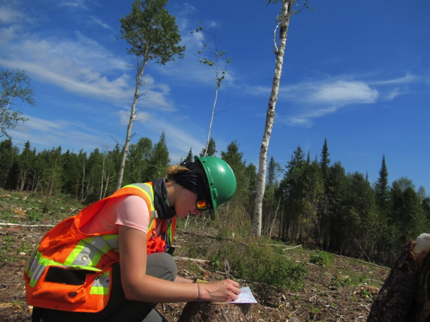
Me hard at work in a cut block.
Being a forester involves a lot of trial and error and understanding what works well in what situations. If an area doesn’t take to seeding and you have to go back and fill plant, then it’s a lesson learned. It’s all about figuring out nature to the best of our abilities and going forward with best practices to produce a sustainable future. When I am writing a prescription, I usually wander about and get a good idea of the soil profile in a few different areas by digging into the ground. I also look at the stumps left behind to get an idea of the previous composition, and the overall access to the block – which is an important factor if you are considering planting. Understanding all parts of a block can be an imitating task for a single person, especially if there is a lot of ground to cover. What has made my life easier this week is the Mavic 2.
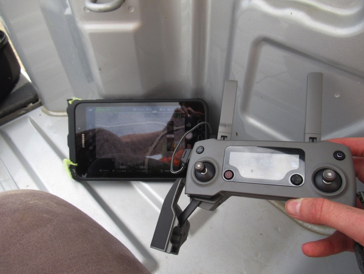 Looking at the entire block from the view of the drone. |
Since this drone is over 250g, I had to pass and obtain my basic pilots’ licence to operate it. The vlog gives you a quick overview of how I use the drone and what it can do. I figured I would go into more detail about what to think about when it comes to laws and regulations with transport Canada below. Here is a quick list of the things you need to comply with and think about when using a drone in Canada:
|
There is a world of opportunity when it comes to using drones in forestry. It saves time and money when trying to figure things out in the bush. They can be finicky to use, and if you are not a techy person like me, it can be frustrating. But as time goes on and with more and more practice, I can see them being an extremely useful and valuable tool. Innovation is important when it comes to sustainability as Resolute is always looking for more ways to become a safer and more educated company to develop future best practices.
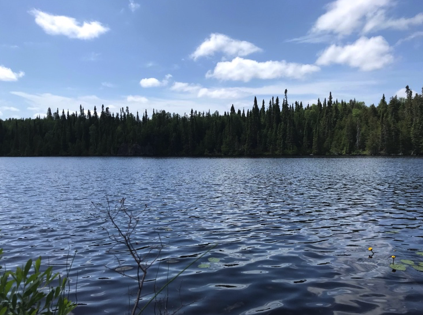
Discovering little lakes is always a nice addition to the day!
Self-innovation is an extremely valuable and important concept to me. I learned a lot while trying to film this vlog, and this kind of experience was exactly what I was looking for in becoming a Green Dream blogger. I am definitely not someone who enjoys talking in front of a camera, and quite frankly I am not very good at it as my face was extremely tense in the first couple minutes of the video. But I am always looking to improve my abilities and hopefully by the end of the summer I can produce a decent video, with good transitions and a relaxed face! So, after watching the video and making notes on what I can do going forward, I am going to work on becoming a much better camera talker! Life is all about lessons and innovation, whether that pertains to your personal growth or forestry!
